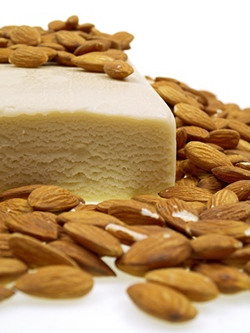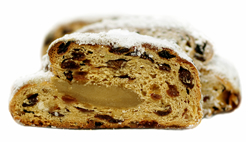Marzipan
Marzipan is a confection made from sugar and ground, blanched almonds. It is a paste used in candy (such as chocolate-covered marzipan) and as fillings for cakes, cookies, and pastries. It is also available in thin sheets. These are used by professional bakers to ice and decorate wedding, birthday, and other fancy cakes.
Marzipan is traditionally made in Northern Germany, but its popularity has spread throughout the country. It is used in many cakes, candies, desserts, and cookies, especially during the Christmas season.
Quality Levels of Marzipan
Marzipanrohmasse (raw marzipan) is the base from which all marzipan is made. This is its simplest form. It contains two-thirds (65%) ground, blanched almonds and one-third (35%) sugar. Marzipanrohmasse is labeled as 100:0, meaning 100% Marzipanrohmasse and 0% extra sugar. From here, different qualities of marzipan are made.
Lübecker Edelmarzipan 90:10
This version is made in the city of Lübeck. It contains 90% Marzipanrohmasse (raw marzipan) and 10% sugar (in addition to the sugar already included in the Marzipanrohmasse - so a total of 45% sugar).
Edelmarzipan 70:30
Contains 70% Marzipanrohmasse (raw marzipan) and 30% sugar (in addition to the sugar already included in the Marzipanrohmasse - so a total of 65% sugar).
Konsummarzipan 50:50
This version is often sold as candy. It contains 50% Marzipanrohmasse (raw marzipan) and 50% sugar (in addition to the sugar already included in the Marzipanrohmasse - so a total of 85% sugar).
Königsberger Marzipan
This version of marzipan was developed in Switzerland. Ingredients include ground almonds, fine powdered sugar, egg white, and a little lemon juice. The finished product has a unique golden/light brown surface.
History
The art of combining ground almonds and sugar into a paste is over 1000 years old and originated in the Orient. It is believed to have been brought to Europe by Arabs through Spain. There, it grew quickly in popularity as a dessert, but only for royalty and the wealthy because of the extremely high price for sugar. It wasn't until the beginning of the 19th century that sugar prices came down and marzipan became a dessert more people could afford.
Marzipan was also used for medicinal purposes well into the 18th centrury. It was used both as a way to make bitter pills more palatable, as well as medicine for specific illnesses. It was known as "energy bread," "heart sugar," and "marzipan for the sick."
Commercial production of marzipan in Germany dates back to 1806 in the city of Lübeck. The Niederegger Bakery began the tradition here and many other bakeries soon followed to make Lübeck the "Marzipan Capital." Today, Lübeck marzipan is known worldwide for its excellence and consistent quality.
World Renowned Marzipan
Marzipan is not unique to Germany. It is made in the United States, Austria, Italy (Marzapane), Spain (Mazapan), Denmark (Marcipan), Portugal (Maçapão), Latin America (Mazapán), the Middle-East (Lozina), and many other counties. However, Germany has a long standing tradition of marzipan production, especially in the state of Schleswig-Holstein. The following brands of marzipan are known worldwide.
Niederegger
Founded in 1806 by Johann Georg Niederegger in the city of Lübeck, Niederegger is the leading manufacturer of Lübecker marzipan. Niederegger marzipan is 100% Marzipanrohmasse (raw marzipan) - labeled as 100:0 (see "Quality Levels" above). Niederegger produces 33 tons of marzipan daily.
Carstens
Founded in 1845 by Charlotte Erasmi in the city of Lübeck, Carstens was one of the first industrial manufacturers of Lübecker marzipan. It played an important role in the growing marzipan industry and was known for its quality. In 1874, Carstens was named the official marzipan supplier to the imperial court of Emperor William I. Today, Carstens offers over 150 products that contain marzipan.
Mozartkugel
A very well known candy made with pistachio marzipan is the Mozartkugel. It was first created in 1890 in Salzburg by Confectioner Paul Fürst. According to the original recipe, a small round ball of pistachio marzipan is covered with nougat, then dipped in dark chocolate.
Today, the Mozartkugel is made both in Germany and Austria. It is only the Fürst Bakery in Salzburg that follows the original recipe and is allowed to label their candies "Original Salzburger Mozartkugel."
Another Austrian manufacturer of the Mozartkugel is the Mirabell Company (Kraft Foods Austria). They produce over 90 million Mozartkugel annually and export to over 30 countries. Their candies differ slightly from the original recipe: a small round ball of green pistachio marzipan is covered in dark nougat, then light nougat, and covered in a layer of chocolate.
The largest German producer of the Mozartkugel is the Reber Spezialitäten Company, founded in 1938. They produce 500,000 Mozartkugel daily and export to over 40 countries. Reber Mozartkugel are made with a center of nougat, then comes a half layer of marzipan and another half layer of green pistachio marzipan, followed by a covering of chocolate.
Another German producer is the Lambertz Company. Their Mozartkugel begin with a whole hazelnut, covered in nougat, green pistachio marzipan, marzipan, then a final layer of semi-sweet chocolate.
|

Photo: © Lucy Dragon - BigstockPhoto.com

| The following products are very similar to marzipan but are made from different base ingredients. Like marzipan, these products are used both in baking and candy making. |
| |
| Nougat |
| Nougat is made from ground hazelnuts, sugar, and chocolate. Depending on the manufacturer's recipe, powdered sugar, cocoa butter, milk powder, and vanilla may also be ingredients. Like marzipan, nougat is used in candy (such as chocolate-covered nougat), as well as fillings for cakes, cookies, and pastries. |
| |
| Persipan |
| Persipan is often used instead of marzipan because it is a less expensive product. It is made from ground apricot and/or peach cores. Some manufacturers also include ground almonds. Its sugar content, up to 60%, is higher than marzipan, to counter-balance its natural bitterness. Persipan is slightly stiffer than marzipan and is used almost exclusively in baking. It is rarely used in candy. |
| |
| Pistazienmarzipan (Pistachio Marzipan) |
| Pistazienmarzipan is marzipan to which 4-8% ground pistachios has been added. This form is most often used in filled chocolates, such as the Mozartkugel. |
| |

Photo: © nmonckton - BigStockPhoto.com
|

